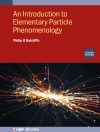This book delves into the world of hybrid photocatalyst nanomaterials and their diverse applications. With a focus on interdisciplinary research, this book highlights the importance of these materials in addressing critical challenges in various fields. The book begins by introducing the significance of multifunctional hybrid photocatalyst nanomaterials and their potential impact on interdisciplinary research. It explores the synthesis techniques employed to create these advanced materials, emphasizing the integration of multiple components to enhance their photocatalytic performance. The applications of hybrid photocatalyst nanomaterials are thoroughly examined throughout the book. From wastewater treatment and energy production to environmental sensing and virus degradation, the diverse range of practical uses is explored in detail. The book also covers recent developments in semiconductor nanomaterials as sensors, screen printing techniques using hybrid nanomaterials, and the use of 2D and 3D printing in sensing applications.
สารบัญ
1. Introduction to semiconductor photocatalyst nanomaterials: Properties, modifications and multifunctional applications.- 2. Synthesis of Multifunctional Hybrid Semiconductor Nanomaterials.- 3. Application of Nanostructured Metal Oxides and Its Hybrids for Inactivation of Bacteria and Viruses.- 4. Advances in semiconductor photocatalyst towards the removal of aromatic volatile organic compounds in air.- 5. Hybrid semiconductor photocatalyst nanomaterials in CO2 reduction and storage applications.- 6. Si O2 based multifunctional hybrid semiconductor nanomaterials and their applications in energy, environment and health.- 7. The Future of Graphene Oxide-Based Nanomaterials and Their Potential Environmental Applications: A Contemporary View.- 8. Hybrid semiconductor photocatalyst nanomaterials for electrochemical sensing applications.- 9. Role of Ti O2-based Photocatalysts in Waste Water Treatment.- 10. Hybrid photocatalyst nanomaterials insolar cell applications.- 11. Transition metal chalcogenides-based nanocomposite for the photocatalytic degradation of hazardous chemicals.- 12. 3D-printed electrochemical (bio)sensors.- 13. Plasmon- Based Metal-Oxides Nanostructures For Biomedical Applications.- 14. Recent advances in Zn O-based hybrid nanomaterials as photoelectrodes for photoelectrochemical water splitting.- 15. Semiconductor-based plasmonic nanohybrids: Synthesis, characterization, mechanistic understanding, and their multifunctional applications.- 16. Polymer-based hybrid composites for wastewater treatment.
เกี่ยวกับผู้แต่ง
Dr. Jai Prakash is an Assistant Professor in the Department of Chemistry, National Institute of Technology (NIT) Hamirpur, India. Prior to joining NIT Hamirpur, he was working as ‘INSPIRE Faculty’ in Indian Institute of Technology (IIT) Kanpur, India. He received his Ph D in 2012 (India). He worked as a postdoctoral researcher at INRS-EMT, Quebec (Canada), Aix-Marseille University (France), Universite Libre de Bruselles (Belgium) and University of the Free State, (South Africa). His major research fields are functional nanomaterials, surface science, ion beam modifications of nanomaterials and Chemistry of materials. His highly interdisciplinary research includes synthesis/characterizations of plasmonic, polymers, metal-oxides semiconductors nanomaterials, their nanocomposites for sensing, optical, photocatalysis, surface enhanced Raman scattering (SERS) related environmental and energy applications.
Dr. Junghyun Cho is a Professor of Department of Mechanical Engineering andthe Materials Science and Engineering Program at the Thomas J. Watson College of Engineering and Applied Science in Binghamton University (State University of New York). Prior to joining Binghamton University in 2001, he was a postdoctoral researcher at the University of California, Santa Barbara (UCSB) (1999-2001). He received his Ph.D. in Materials Science and Engineering from Lehigh University (1998). His research areas cover processing science, microstructure design and development of materials, mechanical behavior and testing, ceramic coatings, and electronic packaging materials and processes including bonding and 3D integration.
Prof. Dr. Bruno C. Janegitz graduated in Chemistry (2006), Master in Chemistry (2009) and Doctorate in Science by the Federal University of São Carlos (2012). He is currently Adjunct Professor C, level 2 and Leader of the Laboratory of Sensors, Nanomedicine and Nanostructured Materials (LSNano) at the Federal University of São Carlos (UFSCar), Araras Campus; Accredited Professor in the Graduate Program in Biotechnology (PPGBiotec) and Graduate Program in Materials Science (PPGCM-So) at the Federal University of São Carlos (UFSCar). He has experience in the Chemistry and Biotechnology areas, working mainly on the following themes: synthesis and characterization of nanomaterials, electroanalytical, electrodes modified with nanomaterials and nanostructured biosensors. Prof. Shuhui Sun is a Full Professor at the Institut National de la Recherche Scientifique (INRS), center for Energy, Materials, and Telecommunications (Montreal, Canada). He is a Fellow of the Canadian Academy of Engineering (CAE), a member of the Royal Society of Canada (College), and Vice President of the International Academy of Electrochemical Energy Science (IAOEES). He serves as the Executive Editor-in-Chief of Electrochemical Energy Reviews (EER, IF=32.8). His research interests focus on Nanomaterials for Energy Conversion and Storage applications, including H
2 fuel cells, hydrogen generation, lithium batteries, Zn-air batteries, Na-ion/Zn-ion batteries, CO
2 reduction, etc












